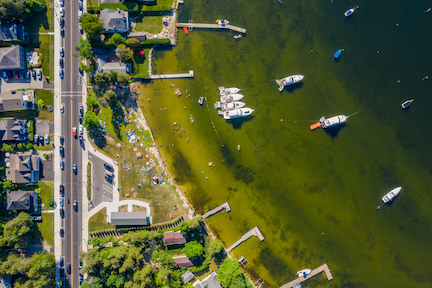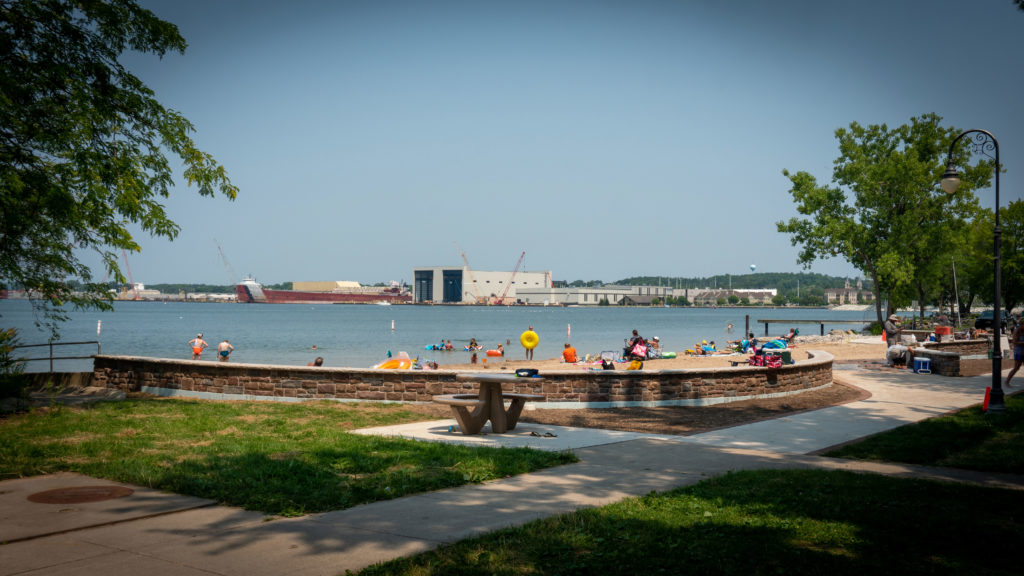Bad Beach Days Aren’t So Bad in Door County
- Share
- Tweet
- Pin
- Share

18 years of beach-water monitoring data shows a few problem beaches, but “remarkably good” water quality overall
It may seem like stating the obvious, but the push to keep fecal pathogens out of beach water is because they can make people sick.
Decades of epidemiological studies and outbreak investigations like Door County Public Health’s after the Nicolet Bay Beach outbreak of 2002 – 68 swimmers came down with a gastrointestinal illness – have linked swimming in polluted waters with adverse human health effects that range from less severe gastrointestinal diseases (diarrhea with sore throats), to non-gastrointestinal diseases (respiratory, ear, eye and skin infections), to more serious illnesses, such as meningitis or hepatitis, according to the Wisconsin Department of Natural Resources (DNR).
People who swim and recreate in water contaminated with fecal pollution are especially at an increased risk of becoming ill because of pathogens from the fecal matter – thus, the concentrated effort Door County and its municipalities have made since 2002 to monitor water at 32 of its 54 beaches and post advisories when E.coli levels are elevated, or closures when the water is not safe for swimming or recreation.
While those 68 illnesses in 2002 may have raised awareness on the need for testing and beach remediation, and the beach-monitoring program is in place to help avoid illness associated with beach-water quality, it’s not easy to learn if people are still getting sick due to swimming.
“Door County Public Health tracks and follows up on E.coli cases, however it is hard to determine the source of E.coli leading to illness, so we don’t have a concrete number of rate of illness related to people swimming in water in Door County,” said Allie McDonald, environmental health specialist with Door County Public Health.
What the Data Shows
There is concrete data on Door County beach health in the form of beach monitoring and assessment reports. Between 2004 and 2021, for example, 5.9% of the 32 beaches tested annually in Door County experienced a beach action day (an advisory or a closing) throughout the season. This percentage ranged over the years from a high of 8.7% of the beaches in 2016, to a low of 3.3% in 2019.
“Most of the beaches, with the exception of one or two, are remarkably good in terms of their water quality,” said Greg Kleinheinz, University of Wisconsin-Oshkosh professor of environmental engineering technology, who’s responsible for Door County’s beach-water monitoring.
The statewide summaries reports back up that statement, regularly indicating that Door County has “relatively low exceedance frequency” at its beaches. In 2021, for example, among the 13 coastal counties involved with beach monitoring, Door County had the third lowest percentage of beach action days (4%), despite having the highest number of beaches in the state, and the highest number tested with the highest frequency. Only Bayfield County (2%) and Iron County (2.5%) had fewer beach action days.
A “beach action day” is considered a day when E.coli levels are elevated enough by federal and state standards to warrant an advisory (swim at your own risk), or elevated enough to warrant a beach closure (no swimming allowed).
Kleinheinz credited beach and stormwater improvements for the gains in Door County beach-water quality, and when there are closures, it’s usually among a predictable few. Overall, for example, locations with higher beach action days tend to be on the Green Bay side of the peninsula, and the problem beaches were identified independently by both Kleinheinz and Greg Coulthurst, Door County Soil and Water Conservation Department conservationist.
Fish Creek Beach is among the beaches that have the most beach action days in Door County, and its challenges could be addressed, they said: a grassy area and parking lot both abut the beach. The geese are attracted to grass and all the surface water runoff from the parking lot and grassy area rolls right into the beach water.
“The problem at Fish Creek,” Kleinheinz said,“is the birds on the beach. They redid it so it’s all grassy lawn and it’s covered in goose feces. That’s something that could be managed differently.”
Fish Creek is included among the beaches with the highest number of beach action days over the past couple of years, a list that includes Otumba Park Beach in Sturgeon Bay; Ephraim Beach; and Frank E. Murphy County Park Beach in the Town of Egg Harbor.
Fish Creek had 11 beach action days in both 2022 and 2023 – nine advisories and five closures in 2022, and five closures and six advisories in 2023.

Many improvements have been made at Frank E. Murphy County Park to try and protect the water quality: dune grasses, sand refortification, the creation of sand dunes and the installation of two tile lines that run parallel to the beach to capture subgrade water from underground springs and move it south.
“These springs are not a water-quality issue but an issue with keeping the sand dry and in place,” Coulthurst said.
But other features remain.
“Murphy’s problem is it has a huge pier out there and things get stuck and there are lots of seagulls,” Kleinheinz said.
Murphy Park had five beach action days in 2023 (four closures, one advisory) and eight in 2022 (six advisories, two closures).
Like the County of Door with Murphy’s, the City of Sturgeon Bay has made extensive improvements at Otumba Park Beach to deter geese, capture and hold surface water runoff. But also as with Murphy’s, there are features for which there are no easy solutions.

“At Otumba, the stormwater discharge for a large part of Sturgeon Bay is right at the beach, one on either side,” Kleinheinz said. “It’s really hard to do much with that; it would be very, very expensive. So there are some that face long-term challenges.”
Otumba typically ranks among the highest number of beach action days: 22 in 2022, for example, which included seven advisories and 15 closures, and 10 in 2023, three of those closures, seven of those advisories.
Ephraim Beach is another that generally makes the top-five list for Beach Action days (11 in 2022, with seven advisories and four closures, and six in 2023, with four advisories and two closures). Coulthurst said his department has never worked with that village on any beach-water projects. He’s also watching Sister Bay Beach, which improved its waterfront in 2015-16, but added a feature that Coulthurst said he’s not sure promotes beach-water quality at that particular location: a groin, which is a perpendicular shore feature used for beach erosion. Coulthurst said it works to keep the sand in place, but he isn’t a fan because it prevents the free flow of water, contributing to bacterial growth. He’s also not certain if it hasn’t invited rather than deterred water fowl.
“To me their improvements may not have improved it [water quality] – according to the data,” Coulthurst said.
In 2022, the beach only had two beach action days (both advisories), but six in 2023 (four advisories and two closures).


